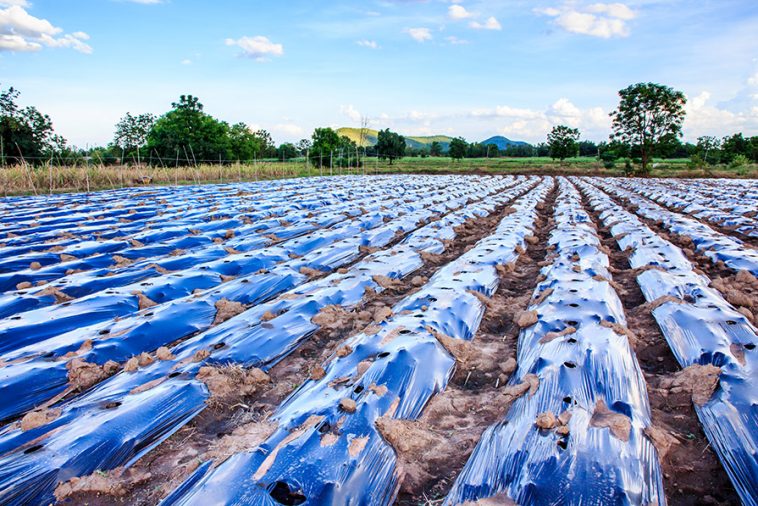There is a growing demand that all agricultural industries take into account the environmental consequences of whatever process they undertake. One of the areas of concern is the use of plastics.
The use of plastics in agriculture has helped farmers to increase crop production, improve food quality, and reduce the geological footprint of their activities, but their negative impact cannot be ignored. As versatile and economical as they are, plastics are found all over farms.
They are used from machines to mulches, they are the stuff of bags and tubs, of tubes and tools, of tags and trays, and of pots and twine. Plastic films are used to cover greenhouses and hug plants around the root zone. Other kinds of plastics are used as ingredients in chemicals. Rosanne (2021) states that world agriculture used 12,5 million metric tonnes of plastic for plant and animal production and 37,3 million tonnes for food packaging in 2019. Globally, packaging is the dominant generator of plastic waste, responsible for almost half of the global total. Plastics used in packaging have a very short ‘in-use’ lifetime (typically around six months or less).
This is in contrast to building and construction, where plastic use has a mean lifetime of 35 years. Plastics encompass a wide range of synthetic and naturally occurring substances that are capable of flow when heated, at which point they can be moulded, extruded, cast, spun, or applied as coating. Synthetic plastics, also known as plastic resins, refer to several dozen families of organic high polymers, which are large, chainlike molecules that contain carbon. Polymers are formed by causing shortchain hydrocarbon molecules, or monomers, to bond though a process known as polymerization.
These monomers are typically oil- or gas-derived, though bioplastics are derived from alternatives to fossil fuels such as vegetable fats and oils, plant starch, and microbiota. (World Bank Group). In the agricultural sector, plastics are single-season use and sooner or later, nearly all plastics end up in landfills, incinerators, waste-to-energy plants, or places where they were never intended to go, or remain.
Certain used plastics can be too costly to remove from farms, and hence are left to pollute the land. Many plastic substances are endocrine-disrupting, and some are carcinogenic and harmful to the nervous and immune system, resulting in their unintended ingestion posing a risk to humans and animals alike. These risks often originate at the time of manufacture, when a range of chemicals including plasticizers, flame retardants, stabilizers, antimicrobials, and antioxidants are used to give plastics their unique properties or to enhance their performance.
Common additives such as bisphenol A (BPA), phthalates, and polybrominated diphenyl ethers (PBDE), for example, are known for their potential to act like a hormone in the body and may increase cancer and other risks. According to Plastics Europe (2022), a number of European countries have implemented National Collection Schemes (NCS) for the management of agri-plastics waste to increase the circular economy and to avoid having a negative impact on the environment.
The model of promoting National Collection Schemes ensures high collection rates as well as an improvement in the quality of the plastic waste collected, both prerequisites for recycling the plastic and the incorporation of recyclates into new products. Several countries have already implemented these NCS, namely France, Germany, Ireland, and Finland, or are starting with them such as the UK and Spain. Once retrieved from the fields, plastics are usually washed to eliminate sand, herbs, and pesticides, before being grinded and extruded into pellets. The material can then be used again in the manufacturing of articles such as outdoor furniture.
When mechanical recycling is not viable, chemical recycling and energy recovery are complementary options with different technologies available. Rosanne (2021) states a FAO report called for improving the management of agricultural plastics through “the 6R model” – refuse, redesign, reduce, reuse, recycle and recover. More specifically, potential solutions could include changing practices to phase out plastic altogether, replacing plastics with biode gradable alternatives or designing better ways to manage or reuse plastic waste. Thus, as the global community moves forward in implementing research and solutions to reduce the effect of plastics, Africa’s farmers should also be aware that they can improve their methods to tackle the crisis.
References
The plastic waste issue: Everything British farmers need to know. Available at: https://bmcontent.affino.com/AcuCustom/Sitename/DAM/298/260419P1213SUOGNP2532.jpg
Sustainable Agriculture. (2022) Available at: https://plasticseurope.org/sustainability/sustainable-use/sustainable-agriculture/
Plastics. Agricultural Pollution. Available at: https://openknowledge.worldbank.org/bitstream/handle/10986/29505/124346-repl-WB-Knowledge-Plastic.pdf?sequence=1
Rosanne, O. (2021) Plastics in soil threaten health and agriculture. Available at: https://www.weforum.org/agenda/2021/12/plastics-agriculture-soil-human-health-un-report/
Plastics in agriculture – an environmental challenge. (2022) Available at: https://www.unep. org/resources/emerging-issues/plastics-agriculture-environmentalchallenge#:~:text=Plastics%20are%20used%20extensively%20in,which%20is%20spread%20on%20 fields
Ritchie, H., Roser, M. (2022) Plastic pollution, Available at: https://ourworldindata.org/plastic-pollution
Twenty firms produce 55% of world’s plastic waste, report reveals. (2021) Available at: https://www.theguardian.com/environment/2021/may/18/twenty-firms-produce-55-of-worldsplastic-waste-report-reveals
The Role of Plastics in Agricultural Applications. (2021) Available at: https://www.plastivision.org/blog/ the-role-of-plastics-in-agriculturalapplications/








